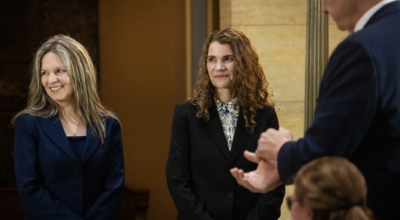Budget forecast: $876M surplus
Published 9:53 am Friday, December 2, 2011
Minnesota is back in the black, but two area legislators say they plan to continue to look for more cost efficient ways to run the government.
“We were pretty happy to see that we had a surplus instead of running another deficit,” said Rep. Rich Murray, R-Albert Lea. “If we’re prudent about how we spend the money and how we take care of the taxpayers’ money, we can operate government more efficiently and effectively.”
The state’s finances turned unexpectedly sunny Thursday when economists projected an $876 million surplus, just months after a bitter budget fight largely shut down its government for nearly three weeks.
The forecast covering the rest of the state’s two-year budget cycle took state lawmakers by surprise. Many were ready for up to $1 billion in new red ink, and the possible repeat of the shutdown stalemate that briefly made the state a national model for political dysfunction. But state forecasters said income and corporate tax collections came in higher than expected, buoyed by an economy that has outperformed other states, and that recent changes in state and federal laws led to lower health-care costs than predicted.
It wasn’t all happy news. Lawmakers can expect a $1.3 billion deficit when they convene in 2013 to pass a new state budget, the forecast said, and the state economist warned that a number of possible scenarios — failure by Congress to extend the payroll tax cut or worsening financial instability in Europe among them — could plunge the state right back into the red by the time of the next economic forecast, in late February.
Minnesotans shouldn’t count on getting any of the surplus money back anytime soon, however. A long-standing state law requires that any surplus funds first go to replenishing the state’s rainy-day budget reserves.
If any money were leftover after filling the reserves, another law would require the state to pay back the nearly $2 billion it has borrowed by delaying state aid payments from public schools in recent years.
“Every family should have a reserve fund, and the state is a big family so we need a reserve fund too,” Murray said. “Now we’ve got some fallback. It’s going to make the state of Minnesota stronger.”
Murray credited the surplus to the hard work of the Republican caucus. He said further tightening of the government’s belt is necessary, but for now everyone is pleased with the surplus.
“This forecast is terrific news for Minnesota,” said Gov. Mark Dayton. Though Rep. Jeanne Poppe, DFL-Austin, was glad to hear the state’s budget is in a surplus, she said there needs to be financial reform so the budget won’t fluctuate as much in the future. She said there was too heavy a burden placed on property taxpayers this year.
“I think definitely the Legislature needs to look at the tax structure,” Poppe said.
Management and Budget Commissioner Jim Schowalter cited two main reasons for the surplus. First, the state ended the previous two-year budget cycle with $526 million more than expected because tax collections were up and spending went down.
Second, state spending for health care, especially Medical Assistance, is predicted to drop $348 million from previous estimates. The state is now scheduled to spend $34 billion from its general fund over the next two years.
Dayton said he might propose some budget adjustments after the next forecast in February. Last year, the predicted budget deficit shrank by more than $1 billion from the fall to the winter forecast. It could happen again, he noted.
If more money rolls into the treasury, he said, he wants to “accelerate our schedule for repaying to our schools the money borrowed from them last summer.”
While the surplus is good news for the state, it’s only a temporary fix. The forecast predicts another $1.3 billion shortfall between revenues and spending in the two-year budget cycle that starts July 1, 2013. That’s down from a $1.9 billion gap forecast in July.
“It was a pleasant surprise, but we need to continue to look at how government operates … so we can make sure the spending stays under control,” Murray said. “Now we can go into session and work on reforming government and not battle over a budget for the next six months.”
Economic forecasters predicted slower growth in the state’s economy through 2013 even than what they had expected last February.
“It’s not that we’re doing as well as we should, it’s not that there isn’t a lot left to do,” said State Economist Tom Stinson. “It’s that we’re outperforming the U.S. economy, and we’re expected to continue to do that as well.”





